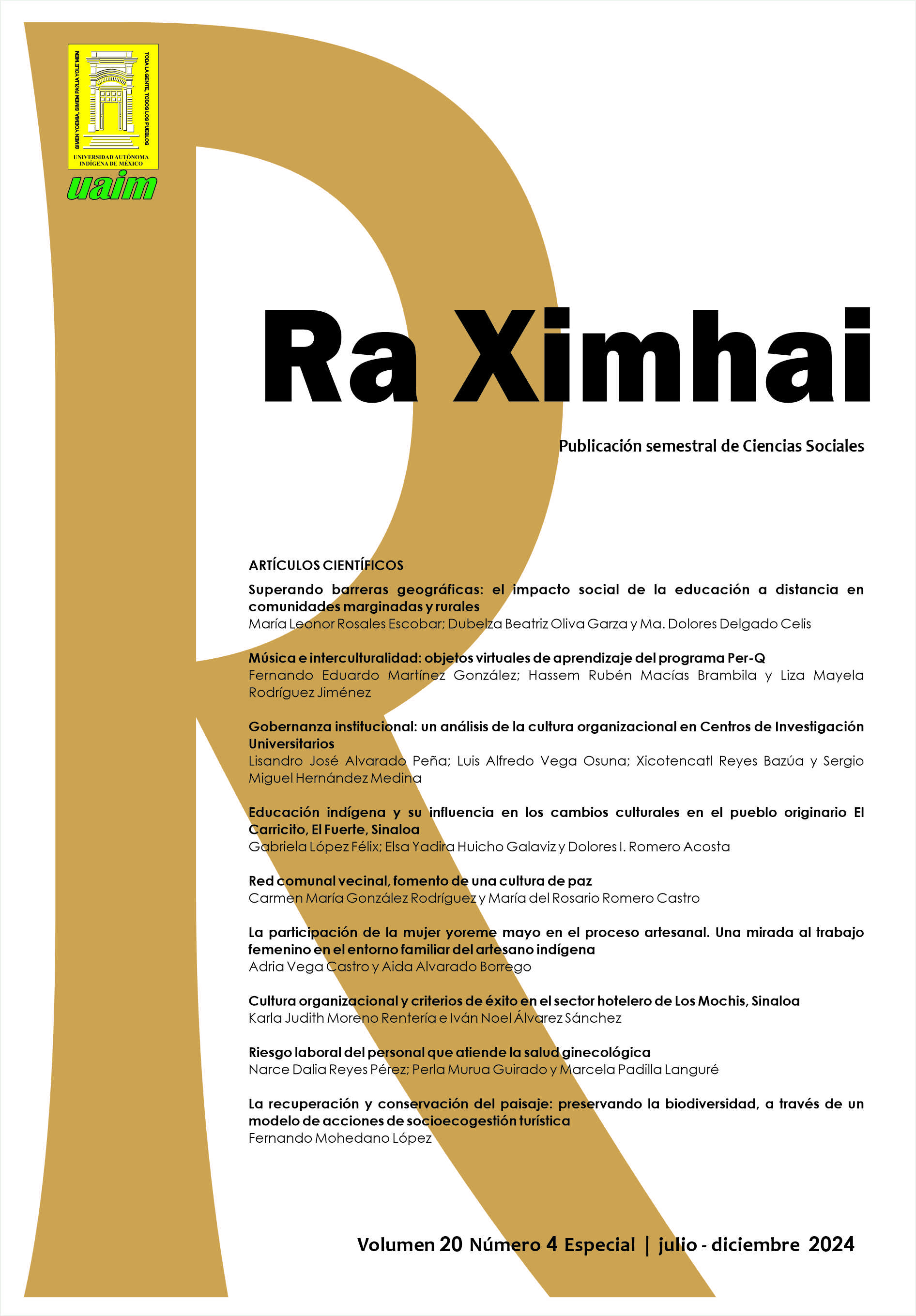The participation of the yoreme mayo woman in the artisanal process. A look at female work in the family environment of the indigenous artisan
DOI:
https://doi.org/10.35197/rx.20.04.2024.06.avKeywords:
crafts, women, double presenceAbstract
This article seeks to recognize female artisanal work, making evident the double participation of women within the family of the artisan of the indigenous community. Show the position that the artisan has within his social environment and the recognition earned for his artisan work. The methodology is qualitative, with directed interviews, surveys on the sales dynamics, questionnaires to the people who carry out the artisan work in the community of San Miguel, Zapotitlán, Sinaloa; as well as the observation of the manufacturing activity. Some women of indigenous origin were heard, confirming the assumption raised: the double presence of women in the domestic sphere and in artisanal work. Yoreme Mayo crafts are divided into two categories: ceremonial use and domestic use. The elaboration of crafts for ceremonial use is carried out mostly by man, due to the process where physical strength is required to transform the raw material from the flora and fauna of the region. Some findings are observed within the family workshops where women (wife, daughter, sister, mother) make clothing, paint, embroider, decorate and assemble the pieces, without ceasing to attend to domestic and family care tasks, finding the time to support men to increase production and therefore the family economy. Work, which is seen by the community and little recognized by those who buy the product, with the man being the one who takes all the prestige.
Downloads
References
Axpe, M. A. (2003). La investigación etnográfica en el campo de la educación. Una aproximación meta-analítica. Tesis Doctoral. Universidad de la Laguna, Santa Cruz de Tenerife, España.
Crenshaw. K. (1989). Teoría de la Interseccionalidad. USA.
Etienne-Nugue, J. (2009). Háblame de la artesanía. París. Ediciones UNESCO.
Flick, U. (2004). Introducción a la Investigación Cualitativa. Ediciones Morata, S.L. Madrid.
Flores, García, Rodríguez, (1996). Metodología de la investigación cualitativa. Ediciones Aljibe. Almería, España.
Gilgun, J.F. (1994) Un caso para estudios de caso en la investigación del trabajo social. Trabajo social. 39, 371- 380.
Hernández, R., Fernández, C., & Baptista, P. (2010). Metodología de la investigación. México D.F: Editorial Mc Graw Hill.
Hernández Sampieri, Roberto. (2006). Planteamiento del problema: objetivos, preguntas y justificación del estudio, Metodología de la Investigación. México: McGraw-Hill, pp. 9-17.
Hill Collins, Patricia. (2000). Black Feminist Thought: Knowledge, Consciousness and the Politics of Empowerment. Routledge, Nueva York.
INEGI (2020). Censo de Población y Vivienda.
Jara Holliday, Oscar. (2018). La sistematización de experiencias: práctica y teoría para otros mundos políticos. Bogotá: Centro Internacional de Educación y Desarrollo Humano CINDE, 258 pp Primera edición, Colombia
Lux, Martha y Pérez M. Cristina (2020). Los estudios de historia y género en América Latina. Historia Crítica, n.° 77 (2020): 3-33, doi: https://doi.org/10.7440/histcrit77.2020.01
Medina del Valle, Ariadna y Armas Arévalos, Enrique (2020): La construcción del sector artesanal, para un desarrollo comunitario. In: Factores Críticos y Estratégicos en la Interacción Territorial Desafíos Actuales y Escenarios Futuros. Universidad Nacional Autónoma de México y Asociación Mexicana de Ciencias para el Desarrollo Regional A.C, Coeditores, Ciudad de México.
Merriam, S. B. (1998). Investigación cualitativa y aplicaciones de estudios de casos en educación. Editores Jossey-Bass de San Francisco. Ruta de Oxford.
ONU (2014). Organización de las Naciones Unidas.
Paredes, J. (2013). Hilando fino desde el feminismo comunitario. CDMX: Cooperativa el Rebozo.
RAE. Real Academia Española.
Rivas, Ramón D. (2018). La Artesanía: patrimonio e identidad cultural. Universidad Tecnológica de El Salvador. Revista de Museología Kóot, 2018 año 8, n. º 9.
Sequera, M. J. (2014). La etnografía: un método de investigación para el ámbito educativo. Revista de Postgrado FACE-UC, 6(15), 169-179.
Stake, R.E. (1994). Estudios de casos. En N.K. Denzin y Y.S. Lincoln (Dirección). Manual de investigación cualitativa (págs. 236-247). Londres: sabio.
Taranilla, Iglesias Andrea (2019). Doble presencia en el ámbito doméstico y laboral. Grado en Relaciones Laborales y Recursos Humanos Facultad de Ciencias del Trabajo universidad de león curso 2019 / 2020. Universidad de León. España.
Zapata Galindo, Martha (2011). El paradigma de la interseccionalidad en América Latina. Ponencia leída en el Lateinamerika-Institut, Freie Universität Berlin, November 17, notes taken by Julia Roth.
Downloads
Published
How to Cite
Issue
Section
License

This work is licensed under a Creative Commons Attribution-NonCommercial 4.0 International License.
Usted es libre de:
- Compartir — copiar y redistribuir el material en cualquier medio o formato
- Adaptar — remezclar, transformar y construir a partir del material
- La licenciante no puede revocar estas libertades en tanto usted siga los términos de la licencia
Bajo los siguientes términos:
- Atribución — Usted debe dar crédito de manera adecuada , brindar un enlace a la licencia, e indicar si se han realizado cambios . Puede hacerlo en cualquier forma razonable, pero no de forma tal que sugiera que usted o su uso tienen el apoyo de la licenciante.
- NoComercial — Usted no puede hacer uso del material con propósitos comerciales .
- No hay restricciones adicionales — No puede aplicar términos legales ni medidas tecnológicas que restrinjan legalmente a otras a hacer cualquier uso permitido por la licencia.








